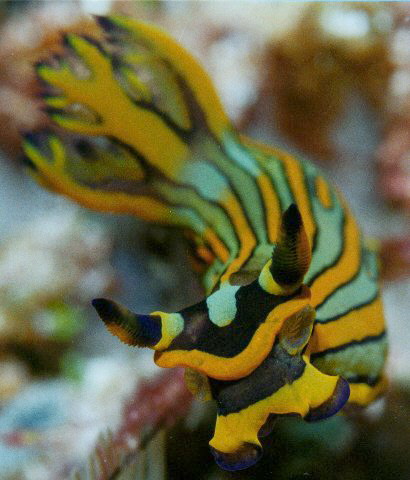
Roboastra arika
Roboastra arika Burns, 1967
A phanerobranch dorid, the gills and rhinophores of Roboastra arika cannot be with drawn into protective sheaths like cyrptobranch dorids. This very beautiful species is recognized by its purplish blue body color with longitudinal yellow stripes, a few of which extend up the gills. Each stripe is surrounded with a black line. A large greenish yellow patch is seen on the head. Externally members of this genus look identical to members of Tambja and Nembrotha. The taxonomic difference is internal, having to do with the dentition of the radular teeth.
R. arika reach 4 cm in length. This species feeds on arborescent bryozoans living on reef walls to depths of 25 meters. It is recorded from the Maldives, where this photo was taken, to Thailand, tropical Australia and New Guinea.
Photo Contributor:
Erwin Kohler
Darmstadt, Germany

I started diving and underwater photography in 1989. First equipment: Nikonos V, SB 103 strobe, several Sea&Sea close-ups. With the years I specialized in macro photography - since summer ´96 merely Opisthobranches (in German I´m called "Nacktschneckenjäger", i.e. slug-hunter), sometimes Flatworms (for Wolfgang Seifarth´s Marine Flatworm Page). November 1996 I sold my Nikonos equipment except the strobe and bought a new equipment: NIKON F 90 X with NIKON 105mm micro-objective, SEALUX housing and another main-strobe: SUBTRONIC MEGA. The old SB 103 is used as slave-strobe. In 1997 I spent 5 weeks diving in the Mediterranean Sea: 1 week Malta, 1 week Spain an 3 weeks Elba,Italy. I took a lot of slug-pictures and am going to specialize in Med. slugs. In 1998 will my "Mediterranean Slug Site" will be created. Send Erwin e-mail at Erwin.Koehler@zentren.postag.de |
Taxonomic information courtesy of:

David W. Behrens
Author:
Pacific Coast Nudibranchs
Send Dave mail at seachalleng@earthlink.net
|
